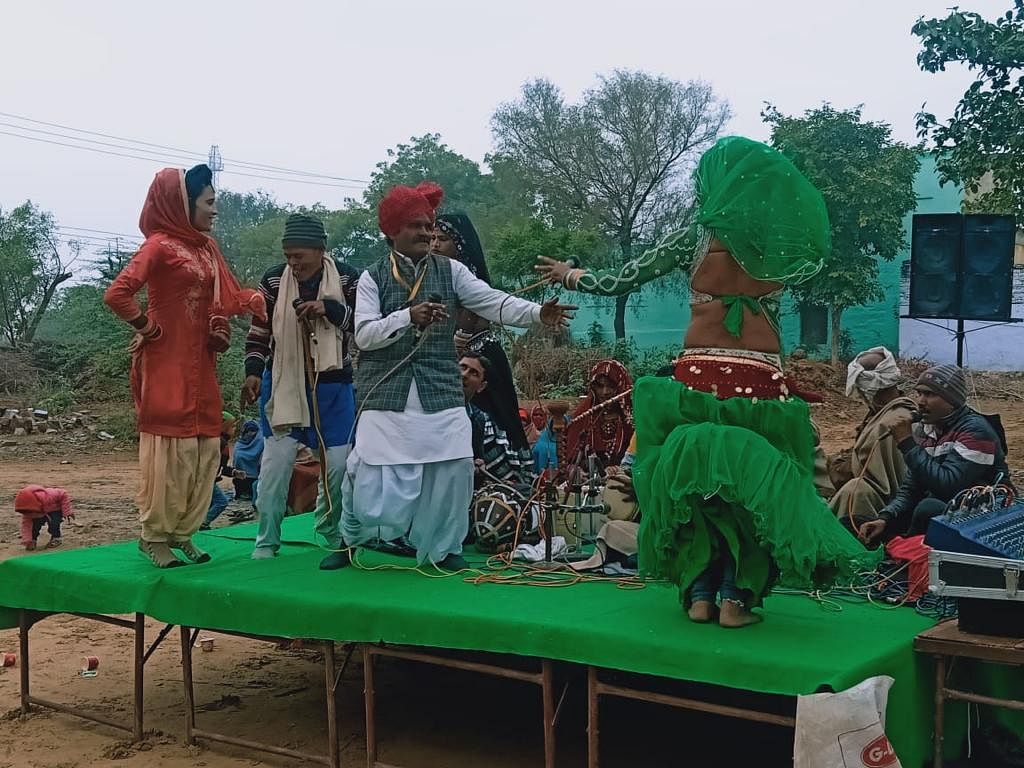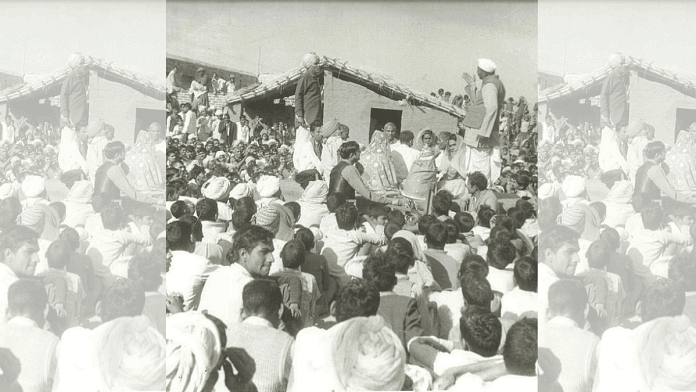Gurugram: Before Bollywood item numbers and comedy open mic nights, Haryana had Saang, a raucous form of folk dance-drama that combined mythological themes, moral lessons, raunchy humour, and men in ghagras. Now, attention is once again turning to this declining art form.
Earlier this week, representatives from various social organisations joined forces with BJP MLA from Kosli, Laxman Singh Yadav, to meet with Haryana Chief Minister Manohar Lal Khattar in Rewari. Their mission: to secure recognition for Master Nekiram, one of the greatest Saang artistes the state has produced, and also to promote the study of Saang.
The delegation submitted several demands to the CM — the establishment of a “Master Nekiram Chair” at Indira Gandhi University in Meerpur (Rewari), a state award in the artist’s honour, and the naming of a roundabout after him in Rewari.
“Master Nekiram hailed from Jaitrawas village of Rewari. He was one of the greatest Saangis (Saang artistes) Haryana ever produced. He served this art form for nearly six decades. That’s why we have demanded recognition for him,” MLA Yadav told ThePrint.
Saang, also known as Swang, which literally means ‘impersonation’, was once a crowd-pleaser in Uttar Pradesh, Rajasthan, and parts of Madhya Pradesh, evolving over centuries.
According to the website of the Haryana government’s Arts and Culture Department, artist Kishan Lal Bhaat brought Saang to its present form in 1750.
Another local celebrity was Deep Chand Bahman, who was known as the “Kalidasa of Haryana” during his heyday in the early 20th century.
“Saang was all about art of storytelling, also known as Dastan Goyi, in which all the action lay in narration. It has characters and actors performing on a rotating stage, telling and enacting stories of kings and queens, history, legends, exploitation, separation, and love,” said Rajbir Deswal, a retired IPS officer and advocate who has written extensively on the culture of Haryana. “There was always a mention of the kind of life that the larger society was exposed to or cohabited in.”
However, Haryana has had challenges in preserving its cultural legacy and folk traditions, especially when compared to neighbouring Punjab.
“Haryanvis haven’t been able to devise their own script, like Gurmukhi, for their dialect. Even the films that are being made in Haryana do not tackle serious content. The same is the case with our poetry, drama, performing arts, or time-tested cultural practices,” Deswal said.
On the demand for a chair in Master Nekiram’s name at the IGU, he said: “Folk literature and culture should find mention in educational institutions and help spread knowledge about the cultural practices of the state of Haryana.”
Also read: Haryanvi songs are moving from vulgarity to veil — ghoonghat is sexualised, male gaze the muse
Wit, cultural commentary, & a tinge of patriarchy
Saang is an ancient form of folk theatre performed by a group of 10-12 artistes in open areas. It combines storytelling, enactment, wit, humor, and commentary on current times. Cross-dressing is common, with male artistes playing female roles too.
Some of the popular mythological themes for Saang are the stories of Bhakt Prahlad, Raja Harishchandra, Raja Bhoj, Draupadi, Padmavati, and Raja Vikramaditya.

According to Deswal, Saang took off from Nautanki, a folk theatre form popular in UP.
“Haryana had a tradition of folk art performances in the form of Chambolas and Kadkas,” he said. While Chambolas are like rhymes conveying some wisdom, Kadkas are witty sayings, he explained.
Notable Saangis from the state, apart from Master Nekiram, he said, are Mange Brahman, Baje Nai, Dada Lakhmi Chand, and Chander Badi. There also has been a woman Saangi who performed under the name of “Kalayat ki Tumman”.
But not all are equally nostalgic about Saang. Mahabir Jaglan, a retired geography professor from Kurukshetra University, highlighted concerns about the gender-insensitive language of the acts, which he said reflects the patriarchal mindset in Haryanvi society.
“I had an opportunity to watch a Saang in my childhood. When I look back now, I realise that while the artiste uses the language of the common people, the dialogue is laced with innuendos…the gender-exclusive language only reflects on patriarchy.”
For him, Saang has not kept up with the times.
“A few years ago, I got an opportunity to watch it again during Ratnawali, a function organised in Kurukshetra on Haryana Day (1 November). That left me even more dismayed,” Jaglan said. “This time, the actors were college students and a teacher had directed them so I expected the language to be a bit refined. But it used the same, old-fashioned idioms and gender-insensitive dialogues and gestures.”
Master Nekiram
Alok Bhandoria, poet and grandson of Master Nekiram, told ThePrint Thursday that the artiste was born 6 October, 1915, at Jaitrawas village of Rewari to Master Mool Chand, also a Saangi.
Master Nekiram’s journey into the world of Saang started in 1929 when he joined his father’s troupe. He continued performing for nearly 60 years, until 1988. Master Nekiram passed away in 1996.
“He created over three dozen Saangs. In his career, he performed in Alwar, Jaipur, Sikar, Jhunjhunu, and Churu districts of Rajasthan besides Rewari, Mahendragarh, and Gurgaon districts of Haryana,” said Bhandoria.
Master Nekiram staged several of his shows for charity for the construction of wells, ponds, dharamshalas, schools and temples, he added.
Bhandoria, who met Khattar as one of the founders of Master Nekiram Sahitya Evam Lok Natya Kala Sanrakshan Parishad, a body working to keep Saang alive, said the idea is to get Master Nekiram the recognition he deserved.
(Edited by Smriti Sinha)
Also read: Haryanvi bravado, nosy bua, fire in the pyjamas—Rakhi Lohchab is killing it on Instagram



